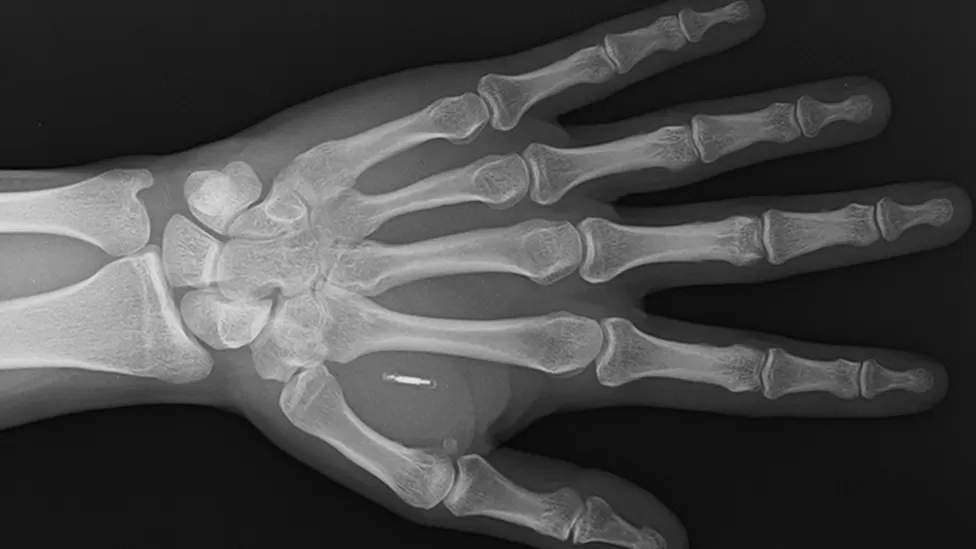Human-embeddable technology. Although it may sound like something from a sci-fi movie, it’s already available and relatively affordable.
Implant a microchip in your hand and you can carry things like your identity cards, credit card info, library card, bus pass, and other information, under your skin.
But that’s not all. Experts predict that, in a few years, human-embeddable technology will not only work as your in-skin wallet but could also be used to help people with disabilities, improve cognitive abilities, and even give us digital immortality.
However, the disadvantages of this tech are already becoming apparent. Some experts are saying that although it can give minor upgrades to the human body, it can yield aggressive downsides in the long term.
So, what’s the real truth? Is human-embeddable technology good, bad, or somewhere in between?
Well, that’s what we’ll look at in this post. We’ll look at implantable tech and its benefits and potential downsides, so you can make the right choices for your health and well-being.
So, let’s begin.
Types of Human-Embeddable Technology
Human-embeddable technology basically means any tech that can be surgically implanted to artificially enhance your body.
It’s not a new concept. The medical industry has been using such technology for a long time. Take pacemakers or implantable cardioverter-defibrillators, for example.
They assist a patient’s body do what it can’t do on its own.
However, such medical devices go to market after rigorous testing and approval from reputed organizations like the FDA. But we can’t say the same for other “biohacking” human-embeddable technologies making their way to the market.
Have a look at some of the implantable devices that are either available in the market or in the funnel.
Human-Implanted RFID Chips
If you look at the X-ray image below, you’ll notice a tiny device between the thumb and the index finger. That’s an RFID chip implanted inside a human hand.

But what is RFID?
RFID, or radio frequency identification, is a form of wireless communication that incorporates radio frequency EMF to securely communicate with other devices.
You know how some hotels give you a card instead of a key to your room? And when you touch the door handle with your card, it automatically opens the door?
That’s RFID in action.
Your card contains a chip with information to disengage the magnet in the door. And when you place the card on the door handle, the device in the handle reads and verifies the information on your card and opens the door for you.
RFID devices are simple to use or program, and they have a multitude of functions.
So, how does an RFID implant help you?
From cardless payments to keyless door entries, an RFID implant can help you in several ways. Besides that, it can also be used for tracking people—just like Apple AirTags.
And since most RFID implants are body-heat powered, you won’t have to take them out to change batteries or re-energize them.
Internal Compass
How would you feel if you could sense north? Then you’d never get lost, and wherever you went, you’d know exactly where you were.
Some birds and animals in our ecosystem already have this ability. It’s called magnetoreception. And migratory birds, bees, and some aquatic animals use this to find their way home.
Sadly, humans don’t have this ability.
But we have technology— and we can use it to mimic the abilities these animals have.
This is what CyborgNest did.
They created a device called North Sense, an artificial sensory implant that detects the earth’s electromagnetic field.
Anyone can purchase this device. All you need to get the implant is your credit card number and a short visit to your local piercing studio.
This device goes inside your chest and vibrates whenever you face the earth’s magnetic pole. According to the company, it creates new neural pathways in the brain, giving you a form of sixth sense.
Brain Chips Implant
You may have heard of Neuralink. It’s a concept gadget by Elon Musk, founder of Tesla & SpaceX, that will be implanted in people’s brains in an attempt to enhance the human body.
Musk says this gadget will record your brain activity and potentially stimulate it.
In one demonstration in 2020, the company showed off one of its chips working inside a pig named Gertrude.
This was a proof of concept demonstration. It showed that the chip could accurately predict the positioning of the pig’s limbs when walking on a treadmill.
The chip also recorded its brain activity when the pig snuffled about for food. Musk said the chip had been inside the pig’s skull for two months.
“In terms of their technology, 1,024 channels are not that impressive these days, but the electronics to relay them wirelessly is state-of-the-art, and the robotic implantation is nice,” said Professor Andrew Jackson, an expert in neural interfaces at Newcastle University.
Although Neuralink is just a concept at the moment and isn’t available to the public, the company continues to perform rigorous testing and optimize the chip for human use.
Benefits of Human-Embeddable Technology
These are just three examples of mainstream progress in human-embeddable technology. There’s more, and according to experts, soon, it will be as common as buying a new phone.

From keyless authenticators and brain biohacking to continuous medical assessments and tracking at-risk patients, technology can and will be used in entirely new ways.
But, it’s not all good news. Human-embeddable technology has the potential to cause more harm than good.
Let’s have a look.
Disadvantages of Human-Embeddable Technology
Of course, implanting a non-medical device inside your body comes with certain risks. But does the risk outweigh the benefits? Let’s look at some of the risk factors associated with human-embeddable technology.
Uncertified Devices
Once a technological concept is out there, uncertified devices begin to surface. This happened with electrical appliances and electronic devices like cell phones.
So, it’s not crazy to think there will be a market for uncertified implantable devices.
In fact, such uncertified devices are already here. Look at this xNT NFC Chip by a company called Dangerous Things.

Right below the purchase section of the product, there’s a warning that says:
“This kit definitely contains dangerous things. While our x-series chip implants have undergone several quality checks during manufacture, and have been put through a battery of tests, they have not been certified by any government regulatory agency for implantation or use inside the human body. Use of this device is strictly at your own risk.”
Uncertified devices are a problem because not only can you waste your money by purchasing them, but they can also impose a serious threat to your health.
Besides that, since it’s not yet a standard surgery to implant such chips inside a human body, many people are taking the black-market route. This means the surgeries would be performed by potentially unlicensed practitioners. And that’s a significant risk on its own.
Security Risks
RFID devices don’t have nearly as much computing power as, say, cell phones. So, because of this, they also aren’t nearly as secure.
And since they don’t have a higher level of encryption, they become easier to access with intermediate hacking skills.
Besides that, since RFIDs are wireless, the interception won’t be noticeable, which creates a new set of problems.
Some are calling this a cybersecurity nightmare. That’s because if an individual implants a microchip in their body, they’d want it to contain a wealth of information—like banking details, identity information, social security information, and more.
And if someone were to intercept and decode the data in this implant, everything in it could be out in the open.
These concerns are based on the current technological capabilities of RFID chips, and only time will tell if they can be drastically improved in the future. Still, privacy is a major concern that will need to be addressed.
Ethical Concerns
Scientists predict that in the next 20 years, neural interfaces will become so advanced that they’ll not only increase the dynamic range of senses but also enhance memory and enable “cyberthink.”
Cyberthink is a concept of having invisible communication with others without using any devices.
Indeed, this technology has the potential to greatly enhance an individual’s quality of life. But it will also give someone in the backend control of how these implants function, what they send and receive, and where the data is stored.

In an article published in the Bioethics and Medical Ethics journal, it says that “ethical appraisal of implantable computer chips should assess at least the following areas of concern:
- Issues of safety and informed consent
- Issues of manufacturing and scientific responsibility
- Anxieties about the psychological impacts of enhancing human nature
- Worries about possible usage in children
- And most troublesome, issues of privacy and autonomy.”
Besides that, the authors also recommend considering the psychological impact of enhancing human nature.
So, the question is, will these brain chips change our conception of humans and our sense of identity? If people are actually connected via their brains, would there be any boundaries and privacy?
Besides these questions, we’re also on the technological path to allow all human beings’ sensory information to be captured in a single tiny microchip. So, do we know that the use of this data will be ethical?
Suicide For the Human Mind Hypothesis
In an op-ed for The Financial Times in 2019, philosopher and cognitive psychologist Susan Schneider said merging human brains with AI would be “suicide for the human mind.”
“The philosophical obstacles are as pressing as the technological ones,” said Schneider.
To illustrate her point, she brought up a hypothetical scenario inspired by Greg Egan, an Australian science fiction writer. Here’s how it goes.
Imagine an AI device called “jewel” implanted in your brain as soon as you were born. It monitors all your brain activities and learns how to mimic your thoughts and behavior.
By the time you’re an adult, “jewel” will have perfectly backed up your brain. After this, even if you surgically remove your brain and let “jewel” control your body, it will be the same.
But at this point, which is the real you? Are you your biological brain or the jewel?
“Because it’s implausible to think that your consciousness could magically transfer to the jewel upon the destruction of your brain,” Schneider reasoned, “it’s more likely that at the moment you opted to remove your brain, you inadvertently killed yourself.”
Keep in mind that this is just a hypothesis. But it is a plausible one. Even though the technology we have right now can’t facilitate such enhancements, it will likely be a reality in the future.
And once it’s advanced enough, how much of our brain will we merge with AI? “Would it be at 15% neural replacement? At 75%? Any choice seems arbitrary,” Schneider wrote.
Where will we draw the line?
Do The Cost-Benefit Analysis
The issue is lots of embeddable tech products we have right now are just frivolous. For instance, I recently visited Dr. Phil’s show for a project where I saw people with microchips in their bodies to unlock doors and cars. Certainly, a problem that we already solved a long time ago with much simpler tech.
I’m not denying that there are big problems that embeddable tech can solve. Take pacemakers, for example. That’s vital, lifesaving technology– and I’d never suggest someone forgo it.
But we also can’t deny the fact that injecting or installing anything into our bodies brings some risks— ones that many of these manufacturers refuse to acknowledge. So, if you’re going to incur that risk, it should bring some value. And I don’t think unlocking a door or starting a car cuts it.
So, if you’re thinking about getting an embeddable tech product surgically implanted in your body, I want you to first do a cost-benefit analysis. If you think it will make your life meaningfully better than it already is, then no doubt, go for it.
But if not, I want you to put a pause on that and continue enjoying life as it is for a while.
Final Thoughts
The growth in technology is unending. And we have to submit to it sooner or later. Because there comes a point where we have no choice—just like we don’t have a choice with cell phones right now.
But the dystopian world scientists have hypothesized with human-embeddable technology isn’t a reality yet.
So, as I mentioned, right now, you have a choice. A choice to carry your credit card instead of implanting its information inside your hand. A choice to carry your house keys instead of having your door open with a hand wave.
See, modern technology is already harming our physical, mental, psychological, and emotional health in various ways.
So, now isn’t the time to focus on adding more technology to our lives. Instead, let’s focus on using the technology we have in a way that benefits us—without subjecting ourselves to the negative effects that tag along.
And that’s exactly what we talk about in The Healthier Tech Podcast—reaping the benefits of technology in a safer, healthier way. So, give it a listen.








